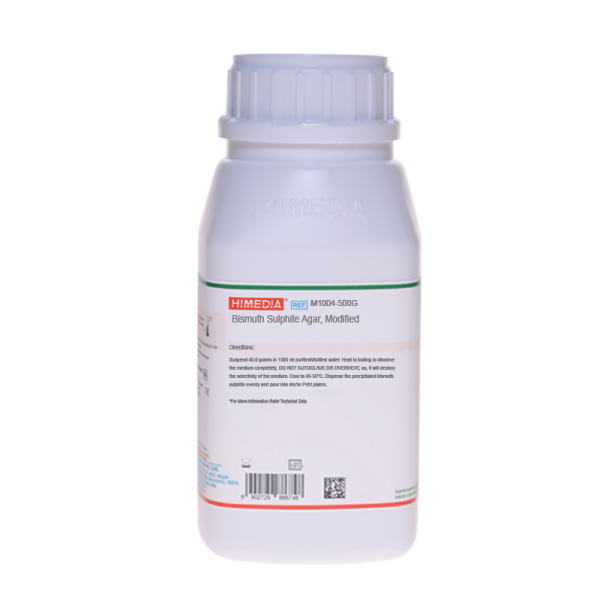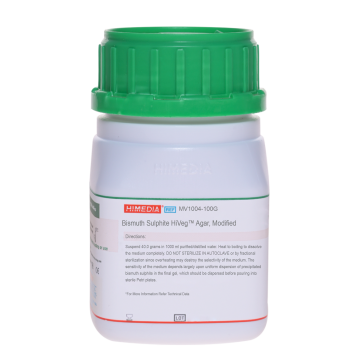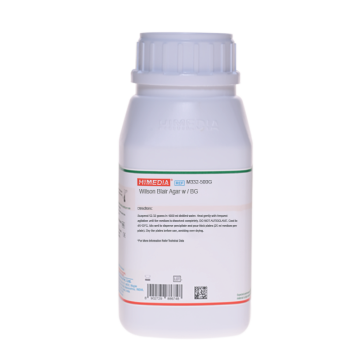 Your enquiry has been submitted
Your enquiry has been submitted
Bismuth Sulphite Agar, Modified
Intended use
Recommended for the selective isolation and preliminary identification of Salmonella Typhi and other Salmonellae from pathological materials, sewage, water supplies, food etc.
Composition**
| Ingredients | g/L |
|---|---|
| Peptone | 5.000 |
| HM Peptone B# | 5.000 |
| Dextrose (Glucose) | 5.000 |
| Disodium hydrogen phosphate | 4.000 |
| Ferrous sulphate | 0.300 |
| Bismuth sulphite indicator | 8.000 |
| Brilliant green | 0.016 |
| Agar | 12.700 |
Final pH (at 25°C): 7.6±0.2
**Formula adjusted, standardized to suit performance parameters
# Equivalent to Beef extract
Directions
Suspend 40.0 grams in 1000 ml purified/distilled water. Heat to boiling to dissolve the medium completely. DO NOT AUTOCLAVE OR OVERHEAT, as it will destroy the selectivity of the medium. Cool to 45-50°C. Disperse the precipitated bismuth sulphite evenly and pour into sterile Petri plates.
The sensitivity of the medium depends largely upon uniform dispersion of precipitated bismuth sulphite in the final gel, which should be dispersed before pouring into the sterile Petri plates.
Principle And Interpretation
The Salmonellae constitute the most taxonomically complex group of bacteria among Enterobacteriaceae (1). Human Salmonella infections are most commonly caused by ingestion of food, water or milk contaminated by human or animal excreta. Humans are the only reservoirs of S. Typhi (2). Four clinical types of Salmonella infections may be distinguished (3) namely gastroenteritis, bacteremia or septicemia, enteric fever and a carrier state. Of the various media employed for the isolation and preliminary identification of Salmonellae, particularly Salmonella Typhi; Bismuth Sulphite Agar is the most productive (4).
Bismuth Sulphite Agar, Modified is a modification of the original formulation of Wilson and Blair Medium (5). It is also recommended for the isolation of Salmonella Typhi and other Salmonella (6,7). S.Typhi, S.Enteritidis and S.Typhimurium typically grow as black colonies with a surrounding metallic sheen resulting from hydrogen sulphide production and reduction of sulphite to black ferric sulphide. Salmonella Paratyphi A grows as light green colonies. Bismuth Sulphite Agar may be inhibitory to some strains of Salmonella species and therefore should not be used as the sole selective medium for these organisms.
Shigella species are mostly inhibited on this medium; exceptions being S. flexneri and S.sonnei and also some Salmonella like S.Sendai, S.Berta, S.Gallinarum, S.Abortus-equi are inhibited (8). Also this medium favors use of larger inoculum as compared to other selective media, as it has unique inhibitory action toward gram-positive organisms and coliforms.
Peptone and HM peptone B serve as sources of carbon, nitrogen, vitamins and essential growth factors. Dextrose (Glucose) is the carbon source. Disodium hydrogen phosphate maintains the osmotic equilibrium. Bismuth sulphite indicator along with brilliant green inhibits the intestinal gram-positive and gram-negative bacteria. Ferrous sulphate aids in detection of hydrogen sulphide production. Clinical samples can be directly used to inoculate Bismuth Sulphite Agar. In case of food samples, pre enrichment of the sample is done prior to inoculation.
Type of specimen
Clinical samples - Blood, faeces and other pathological specimen; Food and dairy samples; Water samples.
Specimen Collection and Handling:
For clinical samples follow appropriate techniques for handling specimens as per established guidelines (9,10).
For food and dairy samples, follow appropriate techniques for sample collection and processing as per guidelines (11-13).
For water samples, follow appropriate techniques for sample collection, processing as per guidelines and local standards (14).
After use, contaminated materials must be sterilized by autoclaving before discarding.
Warning and Precautions :
In Vitro diagnostic Use. For professional use only. Read the label before opening the container. Wear protective gloves/protective clothing/eye protection/ face protection. Follow good microbiological lab practices while handling specimens and culture. Standard precautions as per established guidelines should be followed while handling clinical specimens. Safety guidelines may be referred in individual safety data sheets.
Limitations:
- DO NOT AUTOCLAVE OR OVERHEAT THE MEDIUM, as it destroys the selectivity of the medium.
- S. Typhi exhibit typical brown colonies, with or without metallic sheen.
- This medium is highly selective and must be used in parallel with less selective media for isolation.
- With certain Salmonella species, typical black colonies with metallic sheen is observed near heavy inoculation and isolated colonies may show green colonies.
- Shigella species are mostly inhibited on this medium; exceptions being S. flexneri and S. sonnei.
- Some Salmonella like S. Sendai, S. Berta, S. Gallinarum, S. Abortus-equi are also inhibited.
- The sensitivity of the medium depends largely upon uniform dispersion of precipitated bismuth sulphite in the final gel, which should be dispersed before pouring into the sterile Petri plates.
Performance and Evaluation
Performance of the medium is expected when used as per the direction on the label within the expiry period when stored at recommended temperature.
Quality Control
Appearance Light yellow to greenish yellow homogeneous free flowing powder
Gelling Firm, comparable with 1.27% Agar gel.
Colour and Clarity of prepared medium Greenish yellow coloured opalescent with flocculent precipitate forms in Petri plates.
Reaction Reaction of 4.0% w/v aqueous solution at 25°C. pH : 7.6±0.2
pH 7.40-7.80
Cultural Response
Cultural characteristics observed after an incubation at 35-37°C for 40-48 hours.
| Organism | Inoculum (CFU) | Growth | Recovery | Colour of Colony |
|---|---|---|---|---|
| #Klebsiella aerogenes ATCC 13048 (00175*) | 50-100 | none-poor | <=10% | brown-green(depends on inoculum density) |
| Enterococcus faecalis ATCC 29212 (00087*) | >=104 | inhibited | 0% | |
| Escherichia coli ATCC 25922 (00013*) | 50-100 | none-poor | <=10% | brown-green(depends on inoculum density) |
| Salmonella Typhi ATCC 19430 | 50-100 | good-luxuriant | >=50% | black with metallic sheen |
| Salmonella Paratyphi B ATCC 8759 | 50-100 | good-luxuriant | >=50% | black with metallic sheen |
| Salmonella Enteritidis ATCC 13076 (00030*) | 50-100 | good-luxuriant | >=50% | black with metallic sheen |
| Shigella flexneri ATCC 12022 (00126*) | 50-100 | none-poor | <=10% | brown |
| Salmonella Typhimurium ATCC 14028 (00031*) | 50-100 | good-luxuriant | >=50% | black with metallic sheen |
Key: (*) - Corresponding WDCM numbers.
(#)- Formerly known as Enterobacter aerogenes
Storage and Shelf Life
Store between 10-30°C in a tightly closed container and the prepared medium at 20-30°C, but not for more than 2 days as after which dye oxidizes to give green medium that could be inhibitory to some Salmonellae. Use before expiry date on the label.
On opening, product should be properly stored dry, after tightly capping the bottle in order to prevent lump formation due to the hygroscopic nature of the product. Improper storage of the product may lead to lump formation. Store in dry ventilated area protected from extremes of temperature and sources of ignition Seal the container tightly after use.
Product performance is best if used within stated expiry period.
Disposal
User must ensure safe disposal by autoclaving and/or incineration of used or unusable preparations of this product. Follow established laboratory procedures in disposing of infectious materials and material that comes into contact with clinical sample must be decontaminated and disposed of in accordance with current laboratory techniques (9,10).
Reference
- Tindall B. J., Crimont P. A. D., Gorrity G. M., EUZESY B. P., 2005, Int. J. Sys. Evol. Microbiol., 55:521
- Koneman E. W., Allen S. D., Janda W. M., Schreckenberger P. C., Winn W. C. Jr., 1992, Colour Atlas and Textbook of Diagnostic Microbiology, 4th Ed., J. B. Lippinccott Company
- Mandell G. L., Douglas R. G. Jr., Bennet J. E., (Eds.), 1985, Principles and Practice of Infectious Diseases, 2nd Ed.,660-669, John Wiley & Sons New York.
- Gunter and Tuft, 1939, J. Lab. Clin. Med., 24:461.
- Wilson and Blair, 1927, J. Hyg., 26:374
- Anon, 1981, Int. Standard ISO 6579-1981, Geneva. International Organization for Standardization.
- ICMSF, 1978, Microorganisms in Food, 2nd Edi, University of Toronto Press, Ontario.
- MacFaddin J. F., 2000, (Ed.), Biochemical Tests for Identification of Medical Bacteria, 3rd Edition, Lippincott, Williams & Wilkins, New York.
- Isenberg, H.D. Clinical Microbiology Procedures Handbook. 2nd Edition.
- Jorgensen, J.H., Pfaller, M.A., Carroll, K.C., Funke, G., Landry, M.L., Richter, S.S and Warnock., D.W. (2015) Manual of Clinical Microbiology, 11th Edition. Vol. 1.
- American Public Health Association, Standard Methods for the Examination of Dairy Products, 1978, 14th Ed., D.C.Washington
- Salfinger Y., and Tortorello M.L. Fifth (Ed.), 2015, Compendium of Methods for the Microbiological Examination of Foods, American Public Health Association, Washington, D.C.
- Wehr H. M. and Frank J. H., 2004, Standard Methods for the Microbiological Examination of Dairy Products, 17th Ed., APHA Inc., Washington, D.C.
- Lipps WC, Braun-Howland EB, Baxter TE, eds. Standard methods for the Examination of Water and Wastewater, 24th ed. Washington DC:APHA Press; 2023.
| Product Name | Bismuth Sulphite Agar, Modified |
|---|---|
| SKU | M1004 |
| Product Type | Regular |
| Physical Form | Powder |
| Origin | Animal |
| Packaging type | HDPE |
| References | 1. Tindall B. J., Crimont P. A. D., Gorrity G. M., EUZESY B. P., 2005, Int. J. Sys. Evol. Microbiol., 55:521 |
| Customized Product Available | No |








